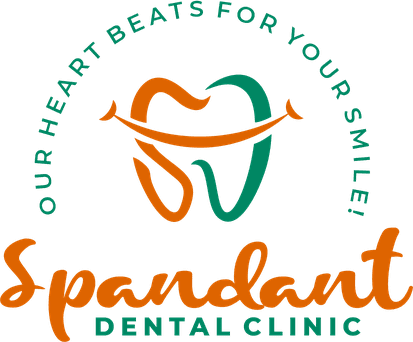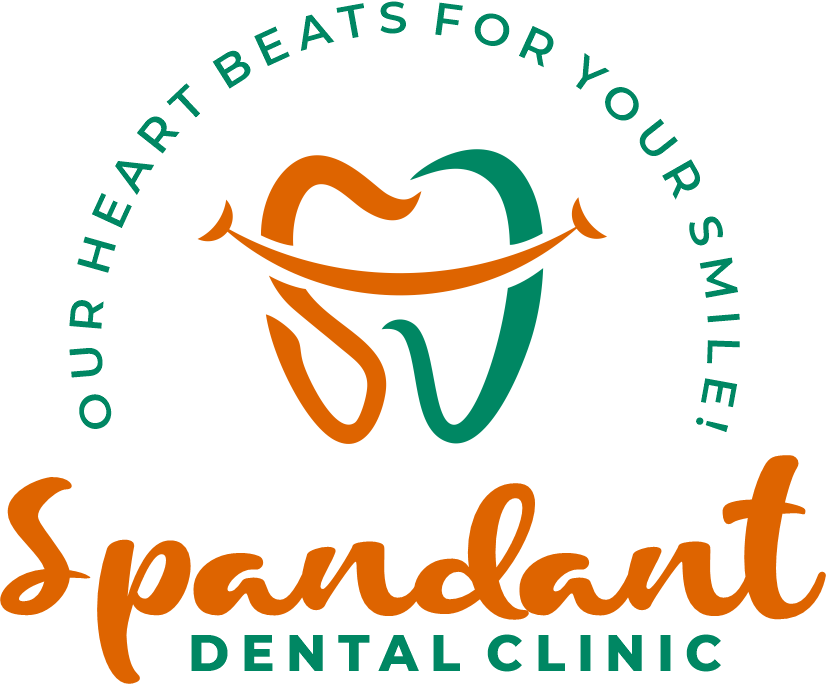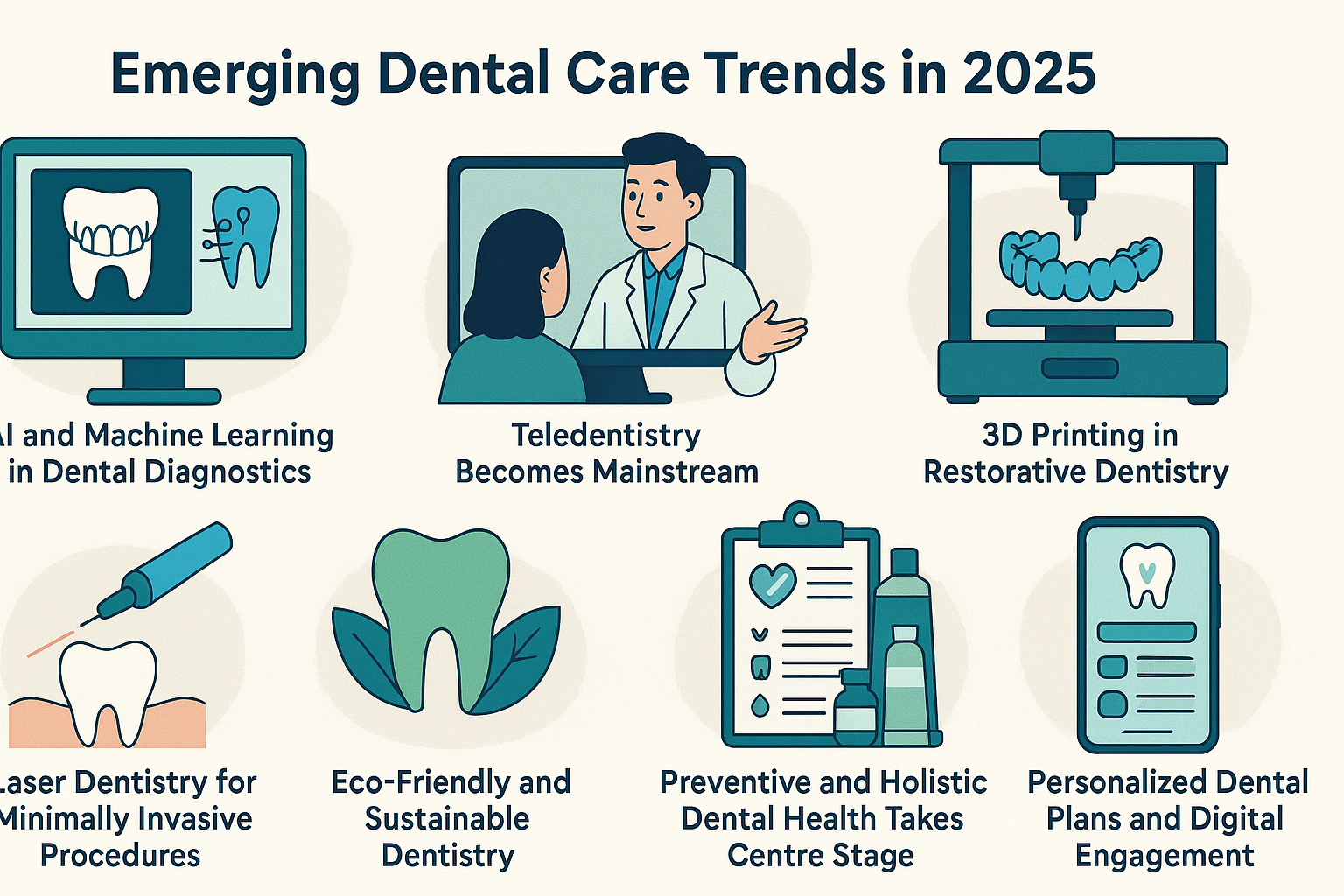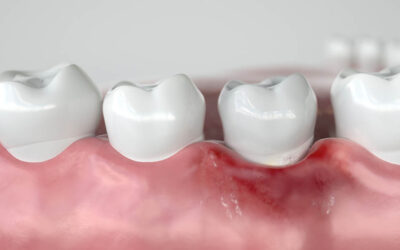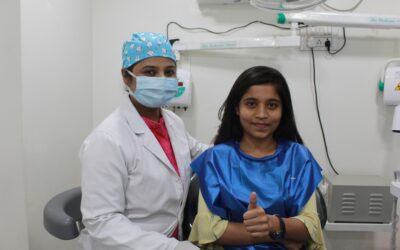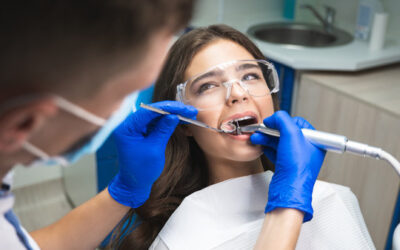A dramatic shift has emerged in the dental field; it is a mix of technology, patient care, and preventive interventions. With 2025 going at its full pace, patients and professionals alike are experiencing significant changes in the oral health delivery and experience.
Whether it is AI diagnostics or sustainable dentistry, the trends in dental care in 2025 are not only improving outcomes but are also changing how people think about visiting the dentist.
In this blog, we are going to point out the best emerging trends transforming dental care, and what they imply to you, your health, and your smile.
1. AI and Machine Learning in Dental Diagnostics
Artificial intelligence is no longer a futuristic scenario, but it is becoming a standard tool in up-to-date clinics. Among the most promising trends in dental care is the introduction of artificial intelligence to achieve diagnostic precision and create a treatment plan. The current AI-based systems aid in:
- Interpretation of dental X-rays and 3D scans
- The ability to identify cavities, gum diseases, or cancer in the mouth as soon as possible
- The formation of individual treatment plans using big data
The use of AI has lowered the number of human errors and sped up diagnoses. Additionally, it provides more personalised dental visits.
What it means to patients: Providing more precise assessments and suggestions of treatment much quicker during check-ups.
2. Teledentistry Becomes Mainstream
Although teledentistry really picked up during the pandemic as one of the key dental care trends, it is also becoming the standard in 2025 dental practice models. With teledentistry, patients are now able to consult remotely with dentists over:
- Pre-treatment conversations
- Second opinions
- Follow-ups and check-in appointments
Not only does this cut down on the number of visits to the clinic, but it also provides rural or underserved patients with access to professional care.
Added Value: Patients do not need to spend time and travel expenses, and are able to get an answer quickly.
3. 3D Printing in Restorative Dentistry
Dental restoration using 3D printing is another of the most innovative trends in dental care. Clinics are using in-house 3D printers to produce:
- Crowns
- Bridges
- Aligners
- Surgical guides
This enables the delivery of the prosthetics instantly or the next day, rather than taking weeks. It also enhances precision and comfort in patients.
Did you know? Custom crowns through 3D printing have become a reality and can be made and fitted in a single appointment in a dental practice!
4. Laser Dentistry for Minimally Invasive Procedures
Laser dentistry is causing the fading away of pain, drills, and lengthy recuperation periods. This technology employs the focused beam of light in carrying out:
- Removal of cavities
- Gum reshaping
- Whitening of teeth
- Surgery on soft tissues
There is less pain, less haemorrhage, and quicker recovery for the patients.
Why it matters: Lower levels of pain and anxiety are possible through the minimally invasive care, and this is particularly relevant among children and sensitive patients.
5. Eco-Friendly and Sustainable Dentistry
The green revolution has even touched on the dental industry. The emphasis on eco-friendly and sustainable dentistry is one of the major dental care trends.
There is the adoption of practices:
- Dental products (floss, toothbrushes), which are biodegradable
- Recording in digital mode to decrease the use of paper
- Mercury-free fillings
- Water-saving equipment and packaging that are recyclable
Did You Know? There are clinics where they can artificially make a zero-waste dental cleaning.
6. Preventive and Holistic Dental Health Takes Centre Stage
Increasing numbers of individuals are realising that there is a strong relationship between oral and general health. This has been driving a preventive and holistic dental trend.
At clinics, there is an accent:
- Nutrition counselling on the health of the gums
- Frequent cleaning and early diagnosis
- Testing saliva in the bloodstream (disease markers)
- Natural or non-fluoride-based product alternatives
Insight: Preventive dental care helps prevent heart disease, diabetes, and sicknesses related to inflammation.
7. Personalised Dental Plans and Digital Engagement
In the year 2025, there is increased authority for the patient. Clinics are adopting technology that would enable patients to:
- Get access to dental records
- Monitor the progress of the aligners or whitening
- Make online appointments
- Receive follow-ups to practice oral hygiene
It is no longer about the one-size-fits-all approach; instead, it is about tailored treatment per smile.
Example: An example is that patients with sensitive teeth can be given special care patterns depending on their DNA or microbiome.
Conclusion
The emerging dental care trends in 2025 and beyond will be more innovative, safer, and more sustainable dentistry. New technology is supporting AI-assisted diagnostics, eco-friendly treatment, and 3D-printed restorations that are described as the emergent realities of the dental experience to improve the experience of the modern patient. When you know about these dental care trends, you can make better choices when it comes to oral health care.
Frequently Asked Questions (FAQs)
1. Have these dental care trends been adopted by the majority of clinics today?
This is an ongoing shift; some clinics have already implemented such technologies, whereas the rest are slowly picking up on this. In urban areas, it will be more common to find dental clinics that provide AI diagnostics, teledentistry, and even 3D printing applications.
2. Does teledentistry work?
Yes. Consultations, follow-ups, and routine advice are suited to tele dentistry. Nevertheless, some processes still need personal attendance.
3.Is 3D dental printing costly?
Although it could be more expensive at the beginning, 3D printing could cost less over time, as laboratory fees decrease and fewer changes are required.
4. Can laser dentistry be used to treat tooth cavities?
In most cases, yes. The decay can be removed, and the tooth can be prepared to receive fillings easily with the use of laser technology that is less painful and requires minimal anesthesia.
5. Do eco-friendly dental products work as well as the old ones?
Absolutely. A significant number of biodegradable products are as hygienic or even more durable than conventional ones. Note that they have to be dentist-approved and certified.
